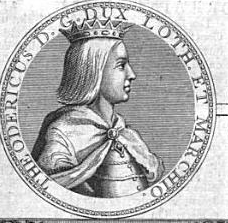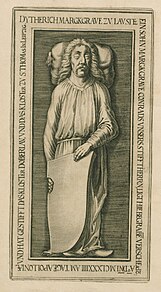
Year 916 (CMXVI) was a leap year starting on Monday of the Julian calendar.
Theodoric is a Germanic given name. First attested as a Gothic name in the 5th century, it became widespread in the Germanic-speaking world, not least due to its most famous bearer, Theodoric the Great, king of the Ostrogoths.

Theodoric II, called the Valiant, was the Duke of Lorraine from 1070 to his death. He was the son and successor of Gerhard and Hedwige of Namur. He is sometimes numbered Theodoric I if the Dukes of the House of Ardennes, who ruled in Upper Lorraine from 959 to 1033, are ignored in favour of the dukes of Lower Lorraine as predecessors of the later Dukes of Lorraine.
Blessed Gebhard von Salzburg, also occasionally known as Gebhard of Sussex, was Archbishop of Salzburg from 1060 until his death. He was one of the fiercest opponents of King Henry IV of Germany during the Investiture Controversy.
John Scotus was a Bishop of Mecklenburg from Scotland. It is likely this John can be identified as the John who was allegedly made Bishop of Glasgow sometime between 1055 and 1060 and possibly the same John allegedly holding the title of Bishop of Orkney.

The Eresburg is the largest, well-known (Old) Saxon refuge castle (Volksburg) and was located in the area of the present German village of Obermarsberg in the borough of Marsberg in the county of Hochsauerlandkreis. It was a hill castle built on the plateau of a low table hill, known as the Eresberg, at a height of 130–150 metres above the Diemel, a tributary of the Weser, in the extreme south of the Saxon Gau of Engern on the border with the Duchy of Franconia.

Conrad I, called the Great, a member of the House of Wettin, was Margrave of Meissen from 1123 and Margrave of Lusatia from 1136 until his retirement in 1156. Initially a Saxon count, he became the ruler over large Imperial estates in the Eastern March and progenitor of the Saxon electors and kings.

Theodoric I, a member of the House of Wettin, was Margrave of Lusatia from 1156 until his death.
Theodoric II was Margrave of Lusatia from 1032 to 1034, the first of the Wettin dynasty.

Henry of Saxe-Lauenburg was a Prince-Archbishop of Bremen, then Prince-Bishop of Osnabrück, then Prince-Bishop of Paderborn.

Eric of Brunswick-Grubenhagen was from 1508 to 1532 prince-bishop of Paderborn and Osnabrück. In 1532, he was elected bishop of Münster, however, he died before he could be consecrated.
Gebhard of Supplinburg was a Saxon count in the Eastphalian Harzgau and Nordthüringgau. He was the father of Emperor Lothair II.
Günther I of Schwalenberg was a German nobleman. He was elected Archbishop of Magdeburg in 1277, but had to step down in 1278. He was Bishop of Bishopric of Paderborn from 1307 to 15 May 1310.

Bernhard of Lippe (1277-1341) was a German nobleman. He was Prince-Bishop of Paderborn as Bernard V. He is considered the founder of the medieval Prince-bishopric. His territoriality focused policies are characterized by the fact that he was the first bishop who used his family name in his seal, instead of the episcopal title.
Dietrich, also known as Dietrich of Ringelheim, was a Saxon count of the Middle Ages.

The Great Gandersheim Conflict was a conflict between the Archbishops of Mainz and the Bishops of Hildesheim concerning the jurisdiction over Gandersheim Abbey. It lasted from 987 to 1030, during the reign of the Ottonian emperors Otto III and Henry II as well as of their Salian successor Conrad II.

Ferdinand of Fürstenberg, contemporaneously also known as Ferdinandus liber baro de Furstenberg, was, as Ferdinand II, Prince Bishop of Paderborn from 1661 to 1683 and also Prince Bishop of Münster from 1678 to 1683, having been its coadjutor since 1667/68. He was brought almost complete restoration to the Bishopric of Paderborn after the devastation of the Thirty Years' War.
Biso was a Bishop of Paderborn.
Dietrich I, otherwise Theoderich, was Bishop of Meissen from 1024 to late 1039 or early 1040.
Theodoric I was the king of the Visigoths from 453 to 466.
This page is based on this
Wikipedia article Text is available under the
CC BY-SA 4.0 license; additional terms may apply.
Images, videos and audio are available under their respective licenses.









